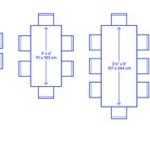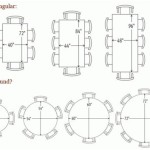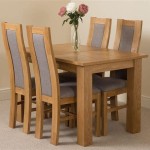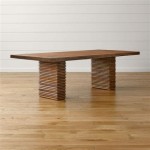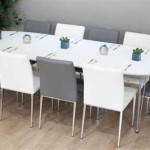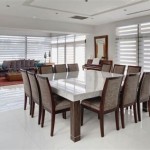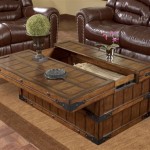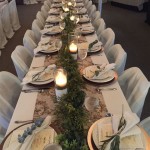The Enduring Appeal of the Mid-Century Modern Round Dining Room Table
The mid-century modern design movement, flourishing roughly from the mid-1940s to the 1960s, continues to influence contemporary interiors. Among the iconic furniture pieces emblematic of this era, the round dining room table holds a significant place. Its clean lines, functional design, and emphasis on natural materials make it a versatile and aesthetically pleasing addition to various home styles. Understanding the characteristics, advantages, and considerations when incorporating a mid-century modern round dining room table into a space is crucial for achieving the desired aesthetic and functionality.
Key Characteristics of Mid-Century Modern Round Dining Room Tables
Mid-century modern furniture is characterized by several defining elements, and round dining room tables are no exception. These tables often showcase a harmonious blend of form and function, prioritizing simplicity and practicality. A thorough examination of the materials, design features, and overall aesthetic reveals the enduring appeal of these tables.
Materials: The choice of materials is a cornerstone of mid-century modern design. Solid wood, particularly teak, walnut, and birch, are frequently used for the table tops and legs. These hardwoods offer durability and a warm, natural aesthetic. The grains of the wood are often highlighted, emphasizing the inherent beauty of the material. Metal, such as chrome or brushed steel, is also commonly incorporated, often for the table legs or base, providing a sleek and contrasting element. Laminates, particularly for table tops, were also popularized during this era, offering a durable and easy-to-clean surface while maintaining a streamlined appearance. The combination of these materials creates a balanced and visually appealing piece of furniture.
Design Features: The designs typically embrace clean lines and a minimalist approach. Round table tops are often thin and unadorned, allowing the natural beauty of the material to shine through. Tapered legs are a hallmark of the style, often angled outwards for stability and visual interest. These legs can be made of wood or metal, and their shape adds a sense of lightness and airiness to the overall design. The use of simple geometric shapes, such as circles and cones, further contributes to the streamlined aesthetic. Some tables may feature a pedestal base, providing a clean and uncluttered look while maximizing legroom. Extension leaves are another common feature, allowing the table to easily accommodate larger gatherings when needed while maintaining a compact footprint for everyday use. The emphasis is on creating a functional and aesthetically pleasing piece that seamlessly integrates into the surrounding space.
Overall Aesthetic: The overall aesthetic is one of understated elegance and timeless appeal. The tables are designed to be functional and practical, without sacrificing visual appeal. The focus on natural materials and clean lines creates a sense of warmth and sophistication. The simplicity of the design allows the table to blend seamlessly with a variety of interior styles, from traditional to contemporary. The mid-century modern round dining room table is not just a piece of furniture; it is a statement piece that adds character and style to any dining space. The emphasis on quality craftsmanship and durable materials ensures that these tables will last for generations, becoming cherished heirlooms.
Advantages of Choosing a Round Dining Room Table
Beyond their aesthetic appeal, round dining room tables offer several practical advantages in terms of space utilization, social interaction, and overall functionality. Understanding these benefits can help homeowners and designers make informed decisions when selecting furniture for their dining areas.
Space Utilization: Round tables are particularly well-suited for smaller dining spaces. Their circular shape allows for easier circulation around the table, maximizing the available space. Unlike rectangular tables, which can create a confined feel in smaller rooms, round tables promote a more open and airy atmosphere. The absence of sharp corners also makes them safer for families with young children. Furthermore, the compact size of many round tables makes them ideal for apartments or condos where space is limited. The ability to easily extend many round tables with leaves provides added flexibility, allowing them to accommodate larger groups when necessary without permanently occupying a large footprint. This adaptability makes them a practical choice for a variety of living situations.
Promoting Social Interaction: The circular shape of a round dining room table encourages conversation and interaction among diners. Everyone seated at the table can easily see and speak to each other, fostering a more inclusive and engaging dining experience. This is in contrast to rectangular tables, where diners at opposite ends may feel disconnected. The equal distance between all diners promotes a sense of equality and camaraderie. This makes round tables particularly well-suited for intimate gatherings, family dinners, and casual meals with friends. The circular arrangement also encourages eye contact and nonverbal communication, enhancing the overall social atmosphere. The design promotes a sense of closeness and connection, making mealtimes more enjoyable and meaningful.
Versatility and Flexibility: Mid-century modern round dining room tables are remarkably versatile and can be incorporated into a wide range of interior styles. Their simple and elegant design complements both traditional and contemporary décor. They can be paired with a variety of seating options, from classic Eames chairs to more modern upholstered dining chairs. The tables can also be easily repurposed for other uses, such as a game table or a work surface. Their compact size and versatility make them a practical choice for multi-purpose spaces. Furthermore, the wide range of available sizes and finishes ensures that there is a round dining room table to suit every taste and budget. Their adaptability and timeless appeal make them a valuable investment that will enhance any living space.
Considerations When Incorporating a Mid-Century Modern Round Dining Room Table
While mid-century modern round dining room tables offer numerous benefits, careful consideration should be given to several factors before making a purchase. Room size, seating capacity, and existing décor are all important aspects to consider to ensure the table complements the space and meets the needs of the users.
Room Size and Table Dimensions: The size of the dining room is a crucial factor in determining the appropriate size of the table. A table that is too large will overwhelm the space and make it feel cramped, while a table that is too small will look out of place. It is essential to measure the dining room and consider the amount of space needed for chairs and walkways. As a general rule, allow at least 36 inches between the edge of the table and any walls or furniture to ensure comfortable movement. The diameter of the table should be proportional to the size of the room. For smaller dining rooms, a table with a diameter of 48 inches or less may be sufficient, while larger rooms can accommodate tables with a diameter of 60 inches or more. Carefully considering the dimensions of the table and the room will help ensure a comfortable and functional dining space.
Seating Capacity: The number of people who will regularly use the table is another important consideration. A smaller table may be sufficient for a couple or a small family, while a larger table is needed for larger families or those who frequently entertain guests. As a general rule, allow approximately 24 inches of width per person at the table. A 48-inch diameter table can comfortably seat four people, while a 60-inch diameter table can seat six. Extension leaves can be used to increase the seating capacity when needed. It is important to consider the overall design of the chairs when determining the seating capacity. Chairs with armrests will require more space than chairs without armrests. Carefully considering the seating needs will help ensure that the table is both comfortable and functional.
Existing Décor and Style: The style and color palette of the existing décor should also be taken into account when selecting a mid-century modern round dining room table. The table should complement the overall aesthetic of the room and not clash with other furniture or accessories. If the room has a minimalist design, a simple and understated table will be the best choice. If the room has a more eclectic style, a table with more character and personality may be appropriate. The color of the table should also complement the existing color palette. Natural wood tones, such as teak and walnut, are versatile and can be easily incorporated into a variety of color schemes. Metal accents, such as chrome or brushed steel, can add a touch of modern elegance. Carefully considering the existing décor and style will help ensure that the table seamlessly integrates into the overall design of the room.

Monte Mid Century Modern Wood Finish 47 Inch Round Dining Table Walnut Brown Baxton Studio

Baxton Studio Monte Mid Century Modern Walnut Wood Round 5 Piece Dining Set Walmart Com

Ashcroft Furniture Co Pia 5 Piece Mid Century Modern Round 43 In Walnut Top Dining Set With 4 Velvet Chairs Orange Ds Pal Wal Eve Org The Home

Round Mid Century Inspired Oak Dining Table Caravana Furniture

Zerifevni 46 4 Round Dining Table Set Mid Century Modern For 6 Person W Steel Legs Coffee Kitchen Room Office Save Space 1 With White

5pc Kimberly Mid Century Modern Walnut Finished Wood Round Dining Set Brown Baxton Studio

Midcentury Modern Finds Mid Century Dining Room Furniture

Mid Century Modern 7 Piece Dining Room Sets 48 Round Table White 6 Side Chairs Homary

Desert Fields Mid Century Modern Round Dining Table Walnut Walmart Com

Ashcroft Furniture Co Crawford 43 In Mid Century Modern Style Solid Wood Walnut Brown Frame And Top Round Dining Table Seats 4 Ash0343 The Home

